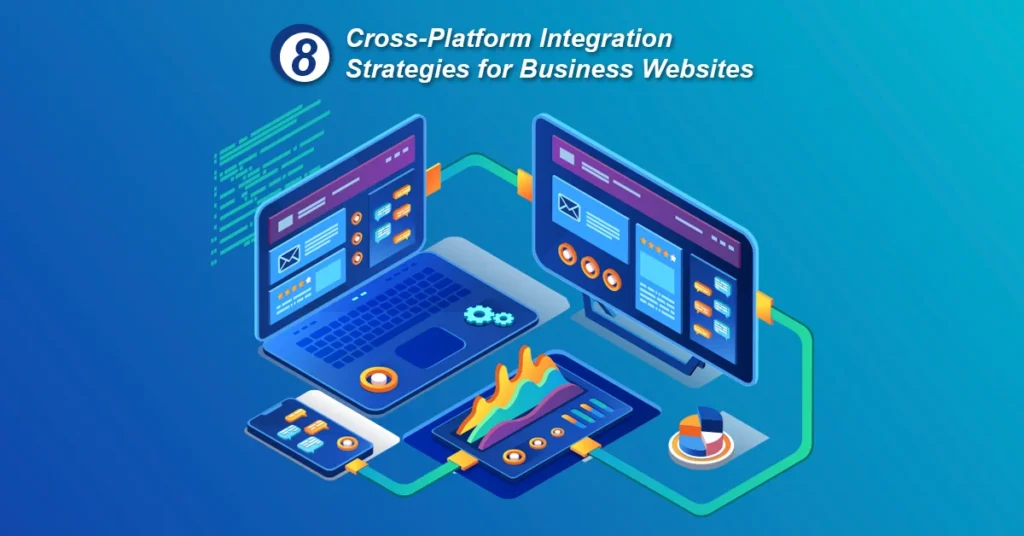
Understanding Cross-Platform Integration for Business Websites
In today’s digital landscape, cross-platform integration has emerged as a critical component for businesses and organisations seeking to streamline their operations and enhance user experiences. But what exactly does this term entail, and why is it so crucial for modern business websites?
What is Cross-Platform Integration?
Cross-platform integration refers to the process of connecting and harmonising various software, hardware, or systems across different platforms, such as different operating systems, devices, or applications. This integration is essential for businesses and organisations to ensure seamless communication, data sharing, and functionality across diverse environments. By unifying disparate elements into a cohesive whole, cross-platform integration enables businesses to deliver consistent experiences to users regardless of the device or platform they are using.
Why Integration is Crucial for Modern Business Websites
The significance of integration becomes evident when considering the findings of recent surveys. For instance, a Gartner survey revealed that an overwhelming 62% of marketers plan to increase their investment in cross-channel marketing, highlighting the growing importance of seamless connectivity across platforms. Furthermore, a survey conducted by Statista found that 64% of respondents cited “cost savings” as the primary reason for developing cross-platform applications, underscoring the tangible benefits that effective integration can yield.
In today’s fast-paced digital environment where users interact with multiple devices on a daily basis, ensuring a cohesive experience across platforms has become paramount. As such, embracing cross-platform integration is not just an option but a strategic necessity for businesses looking to stay competitive and provide exceptional user experiences.
By understanding the fundamental concepts behind cross-platform integration and recognizing its pivotal role in modern business operations, organisations can lay the groundwork for enhanced efficiency and an improved user experience and engagement.
The Role of a Web Developer in Cross-Platform Integration

In the realm of cross-platform integration, web developers play a pivotal role in ensuring seamless connectivity and functionality across diverse platforms. Their expertise and skill set are instrumental in harmonising various systems and technologies to deliver cohesive user experiences.
Skills Required for Effective Integration
Web developers involved in cross-platform integration must possess a diverse skill set that goes beyond traditional web development. Employers seek individuals who can effectively communicate, collaborate with multidisciplinary teams, and adapt to changing project requirements. Moreover, proficiency in utilising APIs, cloud-based services, and software applications that are cross-platform compatible is essential for successful integration efforts.
Adapting to the dynamic nature of technology and business needs, web developers need to stay abreast of the latest trends and best practices in cross-platform integration. This includes staying informed about emerging technologies, industry standards, and evolving consumer behaviours across different platforms.
How Web Developers Facilitate Seamless Integration
Web developers facilitate seamless integration by leveraging their technical expertise to bridge the gap between disparate systems. They work closely with stakeholders to understand business requirements and translate them into effective technical solutions. Through their proficiency in programming languages such as JavaScript, Python, or Ruby on Rails, they develop custom solutions that enable smooth data sharing, application programming interfaces and communication between platforms.
Moreover, web developers ensure that security protocols are robustly implemented across integrated systems to safeguard against sensitive information and data. By employing encryption methods and adhering to industry-specific security standards, they mitigate potential vulnerabilities arising from interconnected platforms.
In addition to technical acumen, effective project management skills are crucial for web developers engaged in cross-platform integration initiatives. They oversee the entire integration process from planning and development to execution and monitoring progress. This involves collaborating with cross-functional teams, managing timelines, and troubleshooting any issues that may arise during the integration process.
By harnessing their technical prowess alongside strong interpersonal skills, web developers serve as catalysts for achieving seamless cross-platform integration that enhances user experiences while driving operational efficiency for businesses.
Key Benefits of Cross-Platform Integration for Your Business

In today’s dynamic business landscape, the implementation of cross-platform integration offers a myriad of advantages for organisations seeking to optimise their digital presence and operational efficiency. By embracing seamless connectivity across diverse platforms, businesses can unlock significant benefits that directly impact user experiences and overall performance.
Enhanced User Experience Across Devices
One of the primary benefits of cross-platform integration is the ability to deliver a consistent and cohesive user experience across various devices and platforms. Whether customers are accessing a website from their desktop, tablet, or smartphone, integrated systems ensure that the interface remains intuitive and functional. This harmonised experience fosters customer satisfaction and loyalty by eliminating disparities in usability and functionality across different devices.
For instance, multinational corporations have streamlined their supply chain management by integrating various software solutions across different regions. This strategic approach has not only enhanced operational efficiency but also provided a significant competitive advantage. Similarly, when businesses integrate their web applications with cloud-based services, they can ensure that users have seamless access to the same data and functionalities regardless of the device they are using.
By leveraging cross-platform integration, businesses can align their digital touchpoints to offer a unified brand experience, thereby strengthening customer engagement and retention. This cohesive approach resonates with modern consumers who expect fluid interactions with brands across all digital channels.
Improved Efficiency and Data Management
Another key benefit of cross-platform integration is the improved efficiency in managing data and streamlining operations. Integrated systems enable real-time data synchronisation, allowing businesses to access accurate information across multiple platforms without delays or discrepancies. This seamless flow of data enhances decision-making processes and empowers organisations to respond swiftly to market trends and consumer demands.
Furthermore, integrated systems and software eliminate redundant tasks and manual data entry processes by automating workflows across platforms. For example, when an e-commerce platform is seamlessly integrated with inventory management software, it enables automatic updates on product availability, pricing changes, and order fulfilment status. This automation not only reduces human error but also optimises resource allocation within the organisation.
The improved efficiency resulting from cross-platform integration extends beyond internal operations to external interactions with customers and partners. Businesses can provide personalised experiences based on consolidated customer data from various touchpoints, leading to targeted marketing campaigns, tailored recommendations, and responsive customer service.
In essence, cross-platform integration empowers businesses to operate more cohesively while enhancing their ability to leverage data-driven insights for strategic decision-making.
Exploring Popular Cross-Platform Integration Tools

In the realm of cross-platform integration, businesses rely on a variety of tools to facilitate effective communication between multiple systems, and streamline their operations. These tools are instrumental in ensuring seamless connectivity and data management across diverse platforms, ultimately enhancing the overall performance of business websites.
Tools for Effective Communication Between Systems
One popular tool for cross-platform integration is Informatica PowerCenter. This robust data integration tool offers features such as data mapping, transformation, profiling, and quality management. With its versatile capabilities, Informatica PowerCenter enables businesses to harmonise disparate software systems, and ensure smooth communication between platforms. By leveraging this tool, organisations can achieve seamless connectivity and real-time data synchronisation across various environments.
Another prominent player in the realm of cross-platform integration tools is IBM InfoSphere DataStage. Similar to Informatica PowerCenter, IBM InfoSphere DataStage provides comprehensive features for data mapping, transformation, profiling, and quality management. This tool empowers businesses to bridge the gap between different systems and streamline their operations through effective communication and data sharing.
Selecting the Right Tools for Your Business Needs
When choosing a cross-platform integration tool for your business, it’s essential to consider your specific requirements and operational objectives. Each tool offers unique functionalities and benefits that cater to different your business processes and needs.
For instance, Microsoft SQL Server Integration Services (SSIS) is renowned for its seamless integration capabilities and robust data management features. This tool equips businesses with the means to automate tasks, reduce manual work, increase efficiency, save time and money, enhance accuracy, and lower errors. By selecting SSIS as a cross-platform integration and data warehouse solution, organisations can optimise their workflows and drive operational excellence.
Similarly, Oracle Data Integrator stands out as a powerful cross-platform integration tool that empowers businesses to automate tasks and workflows while ensuring efficient data management across diverse platforms. The key benefits of this multi-platform integration tool include automating tasks and workflows, reducing manual work, increasing efficiency, saving time and money, increasing accuracy, and lowering errors.
When evaluating potential cross-platform integration tools for your business needs, it’s crucial to assess their compatibility with existing systems, scalability for future growth, ease of implementation, and ongoing support from the provider. By carefully selecting the right tools tailored to your specific requirements, you can lay a strong foundation for seamless connectivity across platforms while driving operational efficiency and cost savings.
How Website Design in Malaysia Adapts to Cross-Platform Needs

In the context of cross-platform integration, website design in Malaysia has evolved to address the diverse needs of businesses seeking seamless connectivity and consistent experiences and functionality across multiple platforms.
Trends in Malaysian Website Design for Integration
Website design in Malaysia has witnessed a significant shift towards responsive and adaptive design principles. With the proliferation of mobile devices and varying screen sizes, Malaysian web designers are prioritising the creation of websites that can seamlessly adapt to different platforms. This approach ensures that users have a consistent and optimised experience, whether they access a website from a desktop, tablet, or smartphone. By incorporating cross-platform integration into their design strategies, Malaysian web developers are aligning with global trends aimed at enhancing user experiences across diverse devices.
Moreover, there is an increasing emphasis on optimising website performance across platforms through efficient coding practices and resource management. Malaysian web development companies are leveraging advanced techniques such as lazy loading of content, image optimization, and minification of code to ensure swift loading times and smooth functionality across various platforms. These efforts contribute to a cohesive user experience while aligning with the core principles of cross-platform integration.
Case Studies: Successful Integration Examples
Clients who have engaged with web development companies in Malaysia have lauded their commitment to delivering seamless cross-platform integration. The web development company received rave reviews for their great job, professionalism, and excellent communication. They were praised for their responsiveness, problem-solving abilities, and support throughout the process. Clients were impressed with the quality of the site and the positive impact on their business. Overall, the company was highly recommended for their expertise and on-time delivery.
One notable case study involves a leading e-commerce platform based in Kuala Lumpur that sought to enhance its cross-platform capabilities. By collaborating with a renowned web development firm specialising in cross-platform integration, the e-commerce platform successfully implemented solutions that harmonised its online storefront across various devices. As a result, the platform experienced a substantial increase in mobile conversions and user engagement metrics. This success underscored the pivotal role of effective cross-platform integration in driving tangible business outcomes.
Another compelling example pertains to a Malaysian hospitality group that aimed to revamp its digital presence by unifying its website experiences across desktops, tablets, and smartphones. Through strategic collaboration with proficient web developers well-versed in cross-platform integration, the hospitality group achieved remarkable results. The integrated website not only delivered consistent branding elements but also facilitated seamless booking processes for users across different devices. This initiative led to heightened customer satisfaction and increased online reservations, demonstrating how adeptly executed cross-platform integration can elevate business performance.
These case studies exemplify how website design in Malaysia is adapting to meet cross-platform needs by delivering impactful solutions that enhance user experiences while driving tangible business outcomes.
Step-by-Step Guide to Implementing Multiple Platforms Integration Strategies

Implementing cross-platform integration strategies requires a systematic approach that encompasses careful planning, execution, and continuous monitoring. By following a step-by-step guide, businesses can effectively navigate the complexities of integration and maximise the benefits it offers.
Planning and Strategy Development
The first phase of implementing cross-platform integration involves meticulous planning and strategy development. This foundational stage sets the tone for successful integration efforts and ensures alignment with business objectives.
Define Integration Objectives
Begin by clearly defining the objectives of the integration initiative. Identify specific outcomes that the business aims to achieve through cross-platform integration, such as improved user experience, streamlined operations, or enhanced data management. By establishing clear goals, businesses can direct their efforts towards tangible results.
Assess System Compatibility
Conduct a comprehensive assessment of existing systems and technologies to determine their compatibility with the intended integration framework. Identify potential bottlenecks or constraints that may impact the seamless connectivity of disparate platforms. This evaluation provides crucial insights for selecting appropriate tools and methodologies for integration.
Stakeholder Alignment
Engage key stakeholders from various departments to gain insights into their unique requirements and expectations regarding cross-platform integration. Collaborate closely with teams responsible for marketing, IT, operations, and customer service to ensure that all perspectives are considered in the planning phase. This inclusive approach fosters a sense of ownership among stakeholders and promotes cross-functional collaboration.
Resource Allocation
Allocate resources effectively by identifying the human capital, financial investment, and technological infrastructure required for successful cross-platform integration. Determine the roles and responsibilities of team members involved in the integration process while ensuring adequate support from leadership to drive the initiative forward.
Execution and Monitoring Progress
Once the planning phase is complete, businesses can proceed with executing their integration strategies while maintaining a vigilant eye on progress through continuous monitoring.
Implementation Roadmap
Develop a detailed implementation roadmap that outlines specific tasks, timelines, dependencies, and milestones associated with cross-platform integration. This roadmap serves as a guiding framework for executing each phase of the integration process systematically.
Agile Methodologies
Embrace agile methodologies such as Scrum or Kanban to foster iterative development cycles within your integration initiatives. These methodologies promote flexibility, adaptability, and responsiveness to evolving requirements throughout the implementation phase. By breaking down complex tasks into manageable sprints or iterations, businesses can maintain momentum while accommodating changes based on real-time feedback.
Quality Assurance Testing
Prioritise rigorous quality assurance testing at each stage of cross-platform integration to identify any discrepancies or malfunctions early in the process. Conduct thorough testing across different platforms to ensure seamless functionality and user experiences regardless of device or operating system.
Performance Metrics Tracking
Establish key performance indicators (KPIs) aligned with your integration objectives and consistently track them throughout the execution phase. Monitor metrics related to user engagement, data synchronisation efficiency, operating system uptime, and error rates to gauge the impact of integrated systems on business outcomes.
Overcoming Common Integration Challenges

As businesses embark on the journey of cross-platform integration, they are likely to encounter a myriad of challenges that can impede the seamless connectivity and harmonisation of diverse systems. Identifying and addressing these integration obstacles is crucial for ensuring the successful implementation of integration strategies.
Identifying and Addressing Integration Obstacles
Cross-Platform Integration Challenges
When delving into cross-platform integration, businesses must navigate through various challenges that can hinder the smooth unification of systems. These challenges include cost implications, scalability concerns, security risks, and compatibility with legacy systems. The cost factor often arises due to the need for specialised tools or expertise required for effective integration.
Scalability concerns revolve around the ability of integrated systems to accommodate growing business needs without compromising performance. Security risks pose a significant obstacle, especially when transferring data across platforms, necessitating robust encryption and data protection measures. Compatibility with legacy systems further complicates integration efforts, as modern platforms may not work seamlessly or align with outdated technologies.
To overcome these challenges, businesses should conduct thorough assessments of their existing infrastructure and identify potential bottlenecks that may hinder cross-platform integration. By understanding the specific pain points related to cost, scalability, security, and compatibility, organisations can develop targeted strategies to mitigate these obstacles effectively.
Tips for Smooth Cross-Platform Integration
Embrace Specialized Software Platforms: Leveraging specialty software platforms designed for cross-platform integration can streamline communication and data sharing across diverse systems. These platforms offer tailored solutions that address compatibility issues while enhancing operational efficiency.
Prioritise User Experience and Data Security: Focusing on ensuring consistent user experiences across platforms is paramount in overcoming integration challenges. By prioritising user-centric design principles and stringent data security measures during transfer processes, businesses can alleviate concerns related to usability and privacy.
Leverage ERP Systems Effectively: While integrating ERP systems across platforms presents its own set of challenges such as cost implications, organisations can harness the capabilities of ERP solutions to centralise data management and streamline operations effectively.
Bridge Legacy Systems with Modern Integration Platforms: To address compatibility issues between legacy systems and modern integration platforms, businesses should explore middleware solutions that facilitate seamless data transfer and transformation processes.
By proactively addressing these common cross-platform integration challenges through strategic planning and targeted solutions, businesses can pave the way for cohesive connectivity across diverse platforms while optimising their digital operations.
Future Trends in Cross-Platform Integration for Business Websites

As technology continues to advance at a rapid pace, the future of integration holds significant implications for businesses striving to maintain a competitive edge in the digital landscape. The escalating investment in cross-platform integration underscores its pivotal role in driving efficiency, productivity, and competitiveness across diverse platforms.
Emerging Technologies and Their Impact
The emergence of cutting-edge technologies such as artificial intelligence (AI), machine learning, and Internet of Things (IoT) is reshaping the landscape of cross-platform integration. These technologies are revolutionising how businesses connect and communicate between different systems, devices, and platforms.
For instance, AI-powered data integration tools can analyse complex datasets from disparate sources and derive actionable insights that fuel informed decision-making processes. Similarly, IoT devices are enabling seamless connectivity between physical assets and digital platforms, creating new opportunities for integrated workflows and operational efficiencies.
Moreover, the adoption of microservices architecture is transforming the way businesses approach cross-platform integration by enabling modular and scalable solutions. This approach allows organisations to break down complex systems into smaller, independent services that can be seamlessly integrated across diverse platforms. By leveraging microservices architecture, businesses can achieve greater flexibility, agility, and resilience in their integration strategies.
Preparing Your Business for Future Successful Cross Platform Integration Needs
In today’s fast-paced digital world, preparing your business for future integration needs is paramount to staying ahead of the curve. Here are a few examples of how cross-platform integration and coordination can help businesses:
Embrace Specialized Software Platforms: Leveraging specialty software platforms designed for cross-platform integration can streamline communication and data sharing across diverse systems.
Prioritise User Experience and Data Security: Focusing on ensuring consistent user experiences across platforms is paramount in overcoming integration challenges.
Leverage ERP Systems Effectively: While integrating ERP systems across platforms presents its own set of challenges such as cost implications.
By proactively addressing these common cross-platform integration challenges through strategic planning and targeted solutions, businesses can pave the way for cohesive connectivity across diverse platforms while optimising their digital operations.




